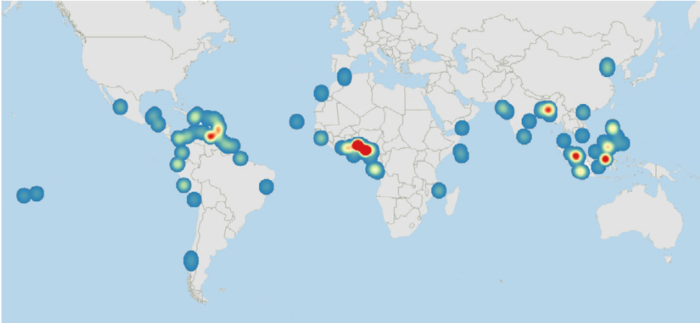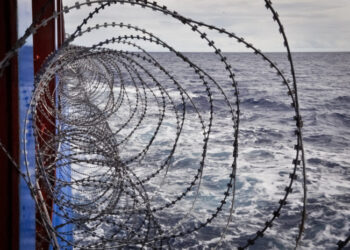One Earth Future and Stable Seas launched the 2018 State of Maritime Piracy, focusing on the human cost of maritime piracy. The report has expanded its attention from just piracy in Somalia, to the Gulf of Guinea, Southeast Asia, and Latin America and the Caribbean.
Specifically, the report aims to explain and quantify the magnitude of these crimes and the profound impact they have not only in the shipping industry, but most importantly in the victims.
The key findings of the report are:
- In 2018, the Gulf of Guinea was the area worst affected by piracy and maritime robbery of vessels worldwide. The number of incidents increased by 15 percent over 2017. The number of attacks where crew members were held for ransom on hijacked vessels or kidnapped for ransom from vessels was alarmingly high.
- No hijackings were reported in the Western Indian Ocean in 2018, including Somalia, the Gulf of Aden, or the Red Sea, in spite of pirate groups retaining the capabilities. This was the result of efforts on land by international agencies, coastal communities, and maritime authorities preventing safe haven for pirate groups. Additionally, the implementation of Best Management Practices (BMP5) by crews and onboard security teams and the efforts of the European Union Naval Force (EUNAVFOR) and Combined Maritime Forces (CMF) and other navies all contributed to decreasing the number of attacks.
- Incidents in Latin America and the Caribbean increased by 20%. Anchorages off Barcelona and the Windward Islands remained armed robbery hotspots.
- Incidents in Asia for the most part remained the same as in 2017. Several suspects were arrested for crimes associated with piracy and robbery of vessels due to effective cooperation by regional law enforcement agencies.
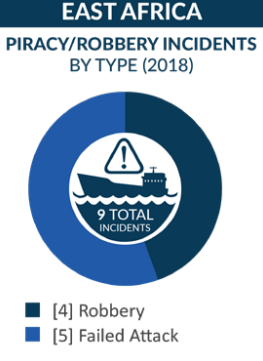
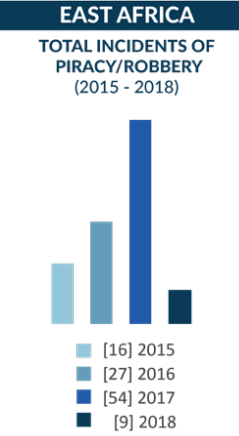
More specifically, the report provides additional information in piracy incidents in East Africa. The incidents were 9 during 2018, in comparison to 2017 which were 54.
Meanwhile, the piracy incidents for 2018 consisted of 4 robberies and 5 failed attacks.
The root causes for piracy off Somalia—the poor socioeconomic situation and political instability in the country—are still present. This latent potential for piracy brought about by coastal violence, weak economic conditions, and the prevalence of crime networks was explored in detail in a 2017 report by One Earth Future
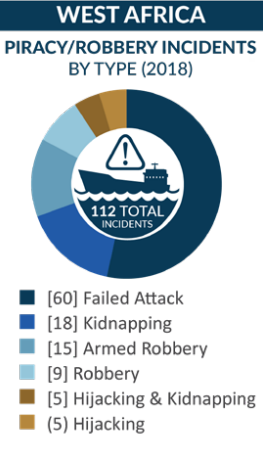
In addition, concerning West Africa, the total incidents for 2018 were 112, and consisted of failed attack, kidnapping, armed robberies,
robberies, hijacking and kidnapping and just hijacking. 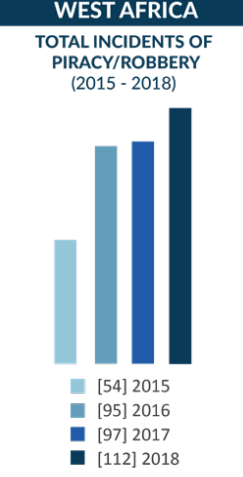
According to the report, in 2018, pirates in the Gulf of Guinea extended their range of attacks in the region, making attacks highly unpredictable.
WEST AFRICA: Crew held hostage:
- Hostages kept for one day or less on a hijacked vessel: 93
- Hostages held for more than one day on a hijacked vessel: 89 (Captivity, where release could be confirmed, ranged from 3 to 10 days.)
- Crew members kidnapped: 102 (A considerable increase. Duration of captivity was 8 to 67 days for cases where release could be confirmed.)
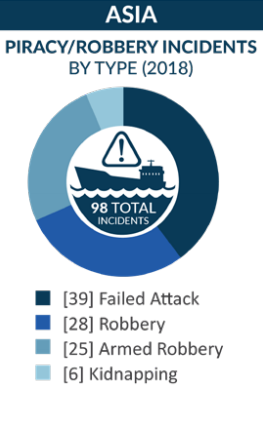 T
T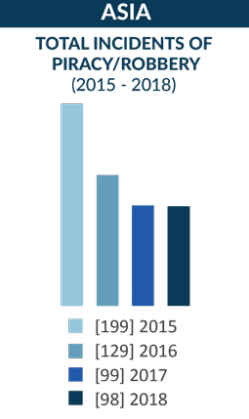 he piracy incidents in Asia were 98 in 2018, and consisted of failed attacks, robbery, armed robbery and kidnapping.
he piracy incidents in Asia were 98 in 2018, and consisted of failed attacks, robbery, armed robbery and kidnapping.
Almost two-thirds of robbery incidents reported in Asia in 2018 occurred when vessels were at anchor. Almost a third of these were at two locations: Muara Berau Anchorage, Samarinda, Indonesia; and Chittagong/Kutubdia Anchorages, Bangladesh.
In 2018, 61 crew members from six separate kidnapping incidents were held hostage in Asia. All of the victims were fishermen.
Two incidents took place off Sabah, Malaysia, and four in the Sundarbans, Bangladesh. The average time crew members were held hostage in the Philippines during kidnapping incidents from 2014 to 2018 was five months. Attackers were armed in 36 incidents. Weapons included iron rods, knives, machetes or long knives, and firearms, some of which were homemade.
Hostages kept for one day or less: 18 Hostages held for more than one day and confirmed as released: 24 Hostages still in captivity from 2016/2017: 5 Hostages kidnapped in 2016/2017 and released in 2018: 5
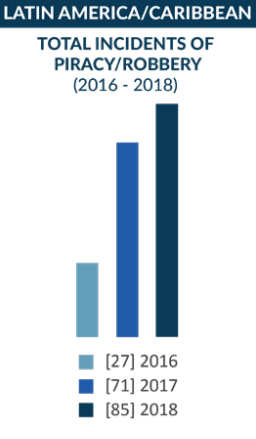
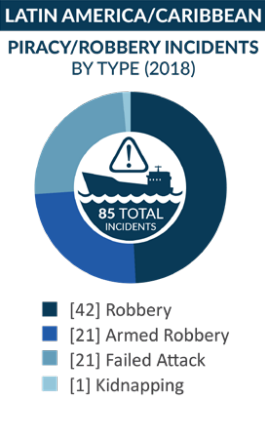
The report also pays close attention to piracy incidents conducted in Latin America and the Caribbean.
Mainly, the piracy/robbery incidents increased in 85 during 2018, in comparison to 2017 which were 71.
The report comments that while the overall number of incidents increased in Latin America and the Caribbean from 2017, this increase was primarily on vessels with smaller crews such as fishing vessels.
In 2018, 858 seafarers were affected by piracy and armed robbery in Latin America and the Caribbean—four more than in 2017. This indicates that the increased incidents were mainly on vessels with smaller crews such as fishing vessels, with incidents on fishing vessels increasing from three in 2017 to 15 in 2018.
For more information on the report, you may click on the PDF herebelow


































